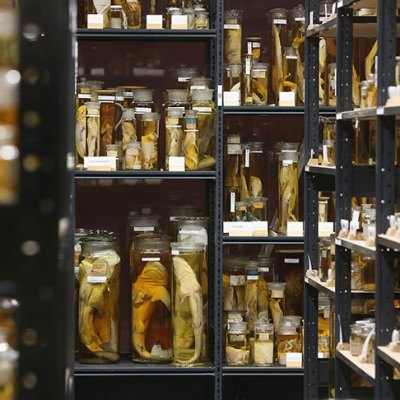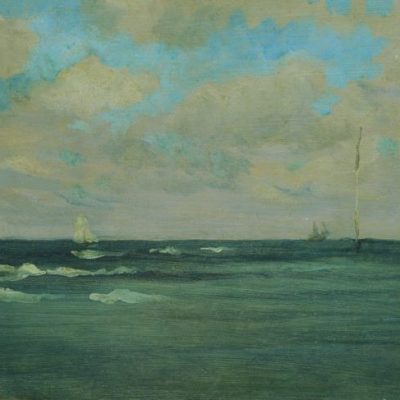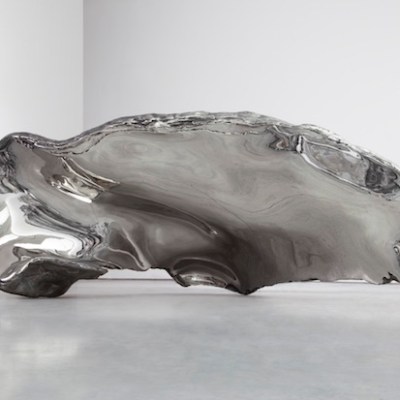In 1828, the geologist Charles Lyell found himself in front of the Temple of Serapis, a Roman ruin on the northern shores of the Gulf of Naples. The temple’s columns, now in fact thought to be the remains of the macellum or marketplace of the town of Puteoli (modern-day Pozzuoli), were already famous in geological circles for the rings that scarred them, caused by marble-boring marine molluscs that had lived on their surface. As these marks were located 12 feet up the columns, they provided compelling evidence that the structure had been submerged in the sea for some time following its ruination, and had then re-emerged. When Lyell published the first volume of his Principles of Geology in 1830, the work that would make his name and influence a young Charles Darwin carried as its frontispiece an engraving of the ruined columns made by antiquarian Andrea de Jorio a decade earlier.
The fact that Lyell prefaced his book with an image of enduring classical architecture rather than fiery natural destruction was significant: the book’s impact lay in its popularisation of the ‘doctrine of uniformitarianism’, the idea that the Earth’s past geological changes had occurred through processes that were visible in the present, over a greatly expanded timescale. Lyell’s work helped to supplant the idea that the Earth had been subject to periodic cataclysms of unprecedented extent, including the biblical flood. The Temple of Serapis provided a visual encapsulation of Lyell’s argument: in fewer than 1,600 years, the land on which it was built had dropped and then risen again due to geological activity; and although this had been accompanied by localised earthquakes and volcanic activity, its fragile columns had withstood the changes wrought on them by what Lyell called the ‘mobility of the land’. Striving to balance mobility with constancy, Lyell drew on the visual symbolism of the ruin, a structure in which the material of the past is both carried forward into the present and is irreparably altered by its transportation.
Frontispiece (detail) of Charles Lyell’s ‘Principles of Geology’ (1830), featuring an engraving of the Temple of Serapis, Pozzuoli, from 1820 by Andrea de Jorio. Natural History Museum, London. Photo: The Natural History Museum/Alamy

This proved a powerful rhetorical tool for Lyell, and he is still considered one of the heralds of the modern era of earth sciences. But the conceptual space that his exemplary ruin gestured to, a space in which geology and culture overlapped, has also been explored by artists and writers, producing plentiful outcroppings of what we might call ‘geological thinking’ over the two succeeding centuries.
By 1856, when John Ruskin published his fourth volume of Modern Painters, Lyell’s stones had started to precipitate a great rockfall, a crisis of faith that would shortly engulf Ruskin himself. Publicly, however, Ruskin still identified the ‘strange quivering’ of Alpine rocks as the expression of ‘their subjection to an Infinite Power’ and quoted Biblical verse in support of this. William Dyce’s celebrated Pegwell Bay, Kent – a Recollection of October 5th 1858 (c. 1858–60), which the artist worked on as Darwin published On the Origin of Species, has been read as an expression of a new uncertainty about humankind’s status in a vastly older and colder universe: the small figures of his family have to take their places besides fossil-bearing chalk cliffs and the celestial phenomenon of Donati’s Comet.
Modernist artists were less concerned with the effect of the geologists’ ‘dreadful Hammers’, as Ruskin called them, on the edifice of faith. In the wake of Surrealism, a number of those who engaged with the movement drew on geology, often in the guise of mineralogy and fossils, to create works that emphasised the past’s sudden eruption into the contemporary. Paul Nash’s painting Ghost in the Shale (1942), executed in watercolour with pen and ink, depicts a contorted, fossilised bird skeleton against a gently subsiding cliff face. Writing in the magazine Axis in 1937, Myfanwy Evans (later Piper) described Nash’s interest in ‘the accumulated intenseness of the past as present’, and indeed the fossil is less ‘in’ the shale than precipitated over it, a jarring juxtaposition reminiscent of Nash’s earlier photomontaged endpapers in the Dorset Shell Guide (1936).
Pegwell Bay, Kent – a Recollection of October 5th 1858 (c. 1858-60), William Dyce. Tate, London. Photo: © Tate
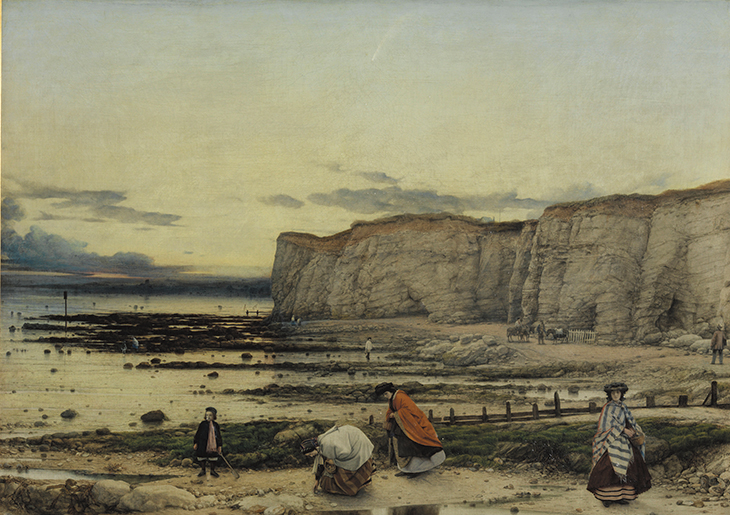
A similarly fractured aesthetic can also be read in some of the work of Ithell Colquhoun, whose allegiance to Surrealism was supplanted by a devotion to esotericism and the occult, but who continued to draw on and develop Surrealist automatic techniques throughout her life. In a trio of prose poems entitled ‘Everything Found on Land is Found in the Sea’, first published in 1943 and later incorporated into her alchemical novel Goose of Hermogenes (1961), geological fault lines fold together stratified landscapes of water and land, metropolis and remote coastline, inner and outer worlds, permitting abrupt transformations in which, for example, the back windows of a London flat open on to a pebbled shore and crashing Atlantic waves.
Roger Caillois, arch-dissident of French Surrealism and an investigator of what the novelist Marguerite Yourcenar termed the ‘mysticism of matter’, was a great lover of stones, collecting many during his lifetime and writing two books about them, Pierres (1966) and L’écriture des pierres (1970). In the latter, Caillois plunges into reveries that freely traverse time and space, finding in the cut and polished surfaces of onyxes, limestones and agates impossible calligraphies, Cubist faces, or Arctic landscapes. These geological specimens are (in Barbara Bray’s translation) ‘witness to the fact that the tissue of the universe is continuous, and that in the vast labyrinth of the world there is no point where apparently incompatible paths […] may not intersect’. Even more so than the fossilised remains of living beings, these rocks formed in the furthest reaches of the earth, absent of any signature of life, echo for Caillois a ‘call from the center of things; a dim, almost lost memory, or perhaps a presentiment […] of a universal syntax’.
This ability of geology to connect immeasurably distant points, whether or not in the mystical mode that Caillois approached, continues to fascinate contemporary artists. It’s particularly interesting to note the ways in which the geological – that apparently most dense, immutable and material of kingdoms – has appeared in the work of artists using ephemeral or time-based forms such as performance, audio art and digital media.
Ghost in the Shale (1942), Paul Nash. John Creasey Museum, Salisbury. Photo: Courtesy the John Creasey Museum, Salisbury
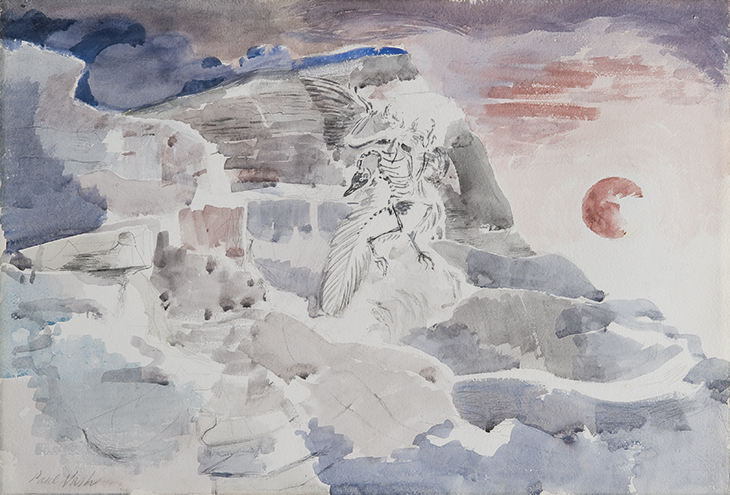
Katrina Palmer’s End Matter project for Artangel (2015) emerges from the landscape of the Isle of Portland, the source of the limestone that for hundreds of years has provided the material for London’s monuments and major buildings, from St Paul’s Cathedral and the British Museum to the Cenotaph. The centuries of excavation have left a landscape that is uniquely hollowed, each missing block a negative space that indexes a distant, emergent architecture, and Palmer’s approach is equally concerned with negatives, afterlives and shadows. End Matter consists primarily of audio work, including The Loss Adjusters, a series of site-specific fictions designed for locations around Portland, and The Quarryman’s Daughters, broadcast on BBC Radio 4. It also takes the form of a book, and associated works have since been installed on gallery walls.
Formally, the relationship between the multiple parts of this project is one of compaction, displacement and expansion, as elements are reconfigured for different presentations and durations. This is fully in keeping with its stony subject; as Palmer writes in the End Matter publication, ‘everything that flourished here in the Jurassic period, vital and fully expanded, ultimately perished, became compacted and compressed’. Geology in the deep oolite beds from which Portland stone is extracted is not experienced as contrasting strata so much as the accretion of massy uniformity – a weightiness that Palmer links to the ‘enormous quantity of death’ the stone has absorbed in the millennia of its formation. The tensions between density and absence, between physicality and mortality, that Palmer divines in the landscape become structuring themes in her layered and intersecting fictions. These range from the story of a gravedigger burying illicit bodies under legitimate corpses in the graveyard (a plot point which appears to be borrowed from a 1939 novel by the Purbeck quarrier Eric Benfield) to a sexual encounter between a team of mysterious researchers (the titular ‘loss adjusters’) and a quarryman’s daughter.
Landscape agate (‘Peak’) from Mexico, from the collection of Roger Caillois. First published in Caillois’s book ‘L’écriture des pierres’
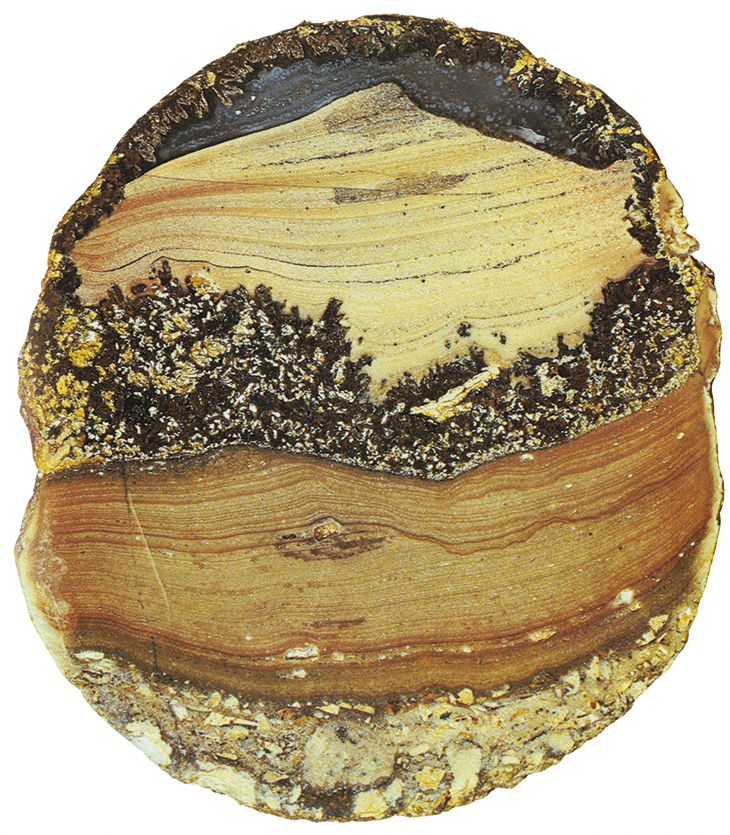
If her choice of subject matter undermines distinctions between ‘literary’ and ‘genre’ writing (such as crime fiction and erotica), Palmer’s treatment of the material resolutely cleaves to her interest in mineral life: the gravedigger is left wandering the island with a barrowful of rubble the same volume as the body he has concealed, while the sex scene emphasises the connection between bodies and stone in the sculptural relief that the foursome makes. In its insistence on the continuum between human bodies and limestone, and the melancholy erotics of this connection, Palmer’s work is reminiscent of the writings of the painter and critic Adrian Stokes, one of the 20th century’s great geological thinkers. In Stones of Rimini (1934), Stokes proclaimed limestone ‘the humanistic rock’; a material ‘carved by the very breath we breathe out’. Carving was a key term for Stokes, a privileged activity that brought out what the stone in a sense desired, the ‘articulation of something that already exists in the block’. Even if Stokes admired limestone carvings chiefly for their static immediacy, elsewhere in his writings flesh and stone flow into each other, sharing the same glowing life, the one electrifying the other as hands polish balustrades, the latter providing the medium for fantasies ‘of fecund moisture in stone, of glimmering forms seen under water, of suctional forces congealed as shapes on the surface of the marble’.
Mikhail Karikis’s performance 102 Years Out of Synch (2013–present) explores a landscape very different from the Isle of Portland: the Devil’s Valley in Tuscany, a geothermally active place of drifting steam, sulphurous rocks and boiling pools. According to local tradition, Dante Alighieri visited the area and drew on it for his depictions of Hell in the Inferno. In 1911, the Inferno was adapted to become Italy’s first feature film; in the same year, the first geothermal energy plant in the world was built in the Devil’s Valley. Karikis constructs his performance around this coincidence, projecting two videos, one composed of clips from the silent film and the other documenting the present-day geological and industrial landscape. Mediating between these two out-of-synch moments is sound: field recordings, pre-recorded vocals, and Karikis’s live improvisatory vocalisations and readings. We talk of the bowels of the earth and the mouths of caves or of Hell itself; Karikis’s drawn-out drones, diaphragm-shaking breath work and whispery vowels turn this idiomatic confusion between the subterranean and the bodily into something audibly concrete.
102 Years Out of Synch (video still) (2013–present), from the project ‘Children of Unquiet’, Mikhail Karikis. Photo: Courtesy Mikhail Karikis
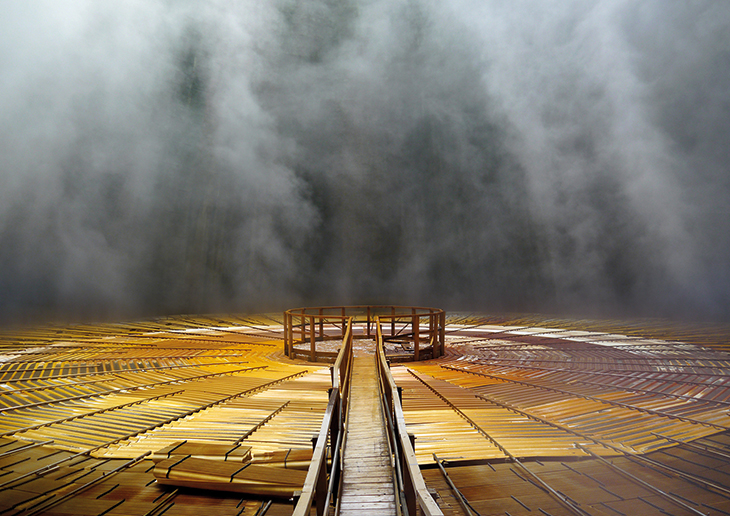
Drawing on a long-standing tradition of the live accompaniment of silent films, Karikis’s sonification is divided into sequences of ‘action’ and ‘narration’. In one of the narrative sections, he identifies the drone of geothermal activity as a kind of interface, a sonic connection between the geological and the industrial, the physical and the metaphysical. It is more than a simple meeting point though: the second half of the work performs a tuning of geology, as geothermal activity is channelled into the pipes and conduits of the power station. Simultaneously, Karikis’s vocalisations reappear as sequenced samples, creating a mechanical aesthetic in which human and geological energies are both entrained. This is far from a techno-utopia, however: scenes from the Inferno show a party of devils jabbing at unfortunate souls with pitchforks, the troubadour Bertran de Born carrying his own head aloft, and Dante and Virgil looking down from a rock bridge into a writhing ditch of the damned. In the piece’s finale, a slow pan up the inside of the power station’s cooling tower towards the distant sky is matched by a view of the two poets slowly walking away from the camera, leaving the darkness of Hell behind as they exit through a craggy fissure.
The triangulation between cinema, geology and the performer’s body also appears in Otobong Nkanga’s Diaoptasia (2015). Where Karikis’s work is configured for the acoustics of each space it is performed in, Nkanga’s performance occurs direct to camera: originally live-streamed by Tate, it now exists online as a YouTube performance. This digital video thus reproduces a stricture of early cinema, in the sense that any editing must be performed in-camera, though with the added constraint that the camera cannot be stopped and restarted. Nkanga responds creatively to these conditions by using hand-lettered intertitles, mobile screens that she slides in front of the camera to allow her to move between backdrops and pick up props, as well as facilitating her Méliès-like illusion of appearing to swallow a large dioptase crystal.
Two intertitles divide her work into three sections: in the first, Nkanga’s copper hair sculpture forms a basket for several crystals: we see the performer’s hands select one, present its lustrous bluey-green to the camera, carefully place it between her teeth and close her mouth. The first intertitle intervenes, reading ‘From where I Stand I See you South’. In the second sequence, the camera roves over a backdrop of fractured rock planes, before focussing on Nkanga’s hands as she scatters glittery powder through the air and across her costume of angular crystalline shapes. There is a soundscape of gentle finger-snaps and vocal humming drones, over which Nkanga reads a poem. ‘Our future is to live with bruises – uneven, hackly, splintery, earthy,’ she recites. The second intertitle is in Nigerian Pidgin: ‘As I tanda so, my eye dey Torchlight una for North.’ The intertitle opens like a door; the camera pulls back and we see Nkanga standing with two rough-cast metal spikes. She sings a song, also in Nigerian Pidgin and based on the words of the intertitle, as she punctures and destroys her cardboard-crystal costume. The finger snaps are replaced by the harder, more uneven percussive sounds of pierced card.
Diaoptasia (video still; 2015), Otobong Nkanga. Photo: Courtesy Otobong Nkanga

The dioptase crystals in Nkanga’s performance, and the image on the backdrop, come from a mine she visited in Namibia which is known for its rare minerals. That country’s brutal colonial history, which has its parallels across the continent, is not mentioned directly in the performance but its presence is tangible. When she asks ‘Would we be able to resist the stress, of the crushing, tearing, bending and breaking?’, ‘we’ is both rock and people, similarly subjected to extractive violence. In this context, the linguistic fracture-line that runs across the performance is significant: Standard English speaks to those who look from the North to the South, while Nigerian Pidgin speaks to those who look from the South to the North. Nkanga was born in Nigeria, and her song addresses a particular language community, those who share a lingua franca created by colonial conditions (language, like geology, allows the past to surface in the present). She creates opacity within global English – an opacity which, in the thinking of Édouard Glissant, is no less than a right. Rather than accepting comprehension – a word rooted in prehendere, to seize – and transparency as the price for recognition of the other, Glissant argued in his Poetics of Relation (1990) for a weave of coexisting, interrelating but irreducible opacities.
Geology itself produces something akin to these woven opacities, presenting those who contemplate it with scenes of fracture, compression and disjuncture, of contrasting elements brought together in improbable intimacy. Fossils, minerals, stones and strata simultaneously resist and accommodate human designs; condensing unimaginable spans of time into indifferent matter, they also offer themselves as the stuff of metaphor. Lyell figured the Temple of Serapis as a cultural illustration of geological truth, but for many artists and writers drawn to the geological, the metaphor has proceeded in the opposite direction: geological materials have become the obdurate vehicles of fantasy, critique and speculation.
From the January 2019 issue of Apollo. Preview and subscribe here.
